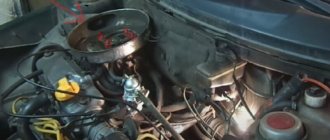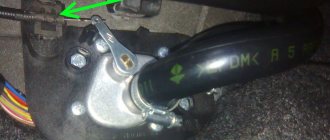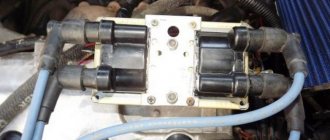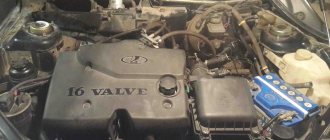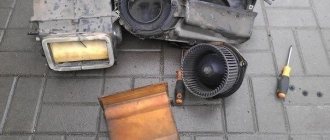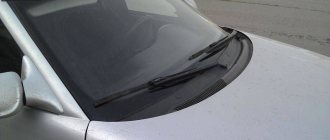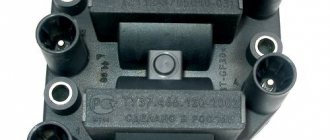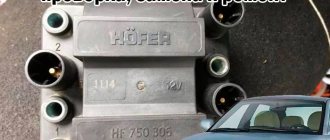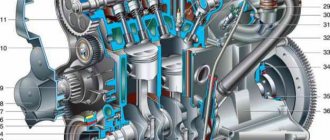Anyone whose car doesn't heat up well and who has a problem with the thermostat is here for everyone. All the information in one place + express test of your thermostat.
I finally figured out how the thermostat should work correctly. The cornerstone in understanding the work was one trick, but more on that below. First, a little theory. All modern thermostats work on the same principle:
1 - radiator; 2 — pipe for coolant circulation; 3 - expansion tank; 4 — thermostat; 5 - water pump; 6 — cylinder block cooling jacket; 7 — cooling jacket of the block head; 8 — heater radiator with electric fan; 9 — heater radiator valve; 10 — plug for draining coolant from the block; 11 — plug for draining coolant from the radiator; 12 - fan
The small circle performs the function of heating the engine. Those. After a cold start, the liquid begins to circulate in a small circle, only through the radiator of the interior heater. Each thermostat has its own large circle opening temperature. Approximately 90oC +/-. After heating to this temperature, the thermostat opens a large circle and the liquid begins to circulate in a large circle and cools in the engine radiator.
It is very easy to check that the thermostat is working correctly.
Just look at how the coolant supply and outlet pipes of the engine radiator and the radiator itself heat up. Warm up the engine to approximately 70°C. The top pipe should be warm and the bottom pipe should be cold. The radiator itself should also be cold (perhaps a little warm on top).
So, what is this cornerstone in understanding the operation of a thermostat?
The large circle opening valve is located in the thermostat on the coolant outlet line from the engine radiator, and not before the supply, as one might logically assume. In theory, if you don’t need to supply coolant to the large circle, close the inlet. But no - the 308s have a closed exit))) I don’t know about other cars...
After the engine has reached a temperature of approximately 90°C, the thermostat opens (the outlet opens) and hot liquid begins to circulate through the engine radiator. Accordingly, the radiator and the lower hose from the radiator warm up. The top one will always be a little hotter than the bottom one.
Why does the top pipe heat up after a cold start?
The liquid that circulates in a small circle heats the liquid that remains motionless in the radiator. By regular mixing, because The entrance to the great circle is always open.
What problems could there be with the thermostat?
:
1. Stuck in open position. The coolant always flows in a large circle.
In this case, at sub-zero temperatures the engine will take longer to warm up. While driving, especially at high speeds and at low engine speeds, the coolant temperature will drop. Example: We warmed up the car to 70 degrees. Go. We went out onto the highway. Engine temperature does not rise or drop. It turns out that the liquid is always cooled on the engine radiator. The thermostat cannot close the large circle when needed.
2. Stuck in closed position.
No liquid flows through the engine radiator. The engine will overheat. Most likely there will be an error in the bookmaker. The fan in front of the radiator will often turn on and run at the lowest speeds.
3. Stuck in the middle position.
It will be something between 1 and 2.
4. Doesn't close completely.
It didn't jam. It works, i.e. Opens a large outline. But he can’t close down completely. There are no errors in BC. This is my situation. Perhaps there are deposits in the thermostat, preventing it from closing or something else, I don’t know. But it works like this: after a cold start, the upper pipe, the radiator from top to bottom, and the lower pipe begin to gradually warm up. Those. Some of the liquid circulates in a large circle (the thermostat is slightly open), some in a small circle. By 70 degrees both pipes and the radiator are hot. Hence we have a longer engine warm-up. It's 70 degrees, let's go. If it’s cold outside and especially a headwind, the road is clear - you can drive for a very long time without warming up to 90. This part of the liquid that travels along the large circuit is cooled and merges with the rest of the liquid. Warming up faster in traffic jams. There is less cooling from the engine radiator. Now with a slight plus. The car warms up faster. It also reaches 90 faster. Perhaps there is simply a small gap in the large circle that remains when closed. If it were big, it definitely wouldn’t get warm.
The design of the VAZ 2110 cooling system
The main function of the cooling system is to maintain the engine operating temperature at 98-103°C. When the engine is running, the heat of the working parts is removed using coolant that constantly circulates in the system. While the engine is heating up, antifreeze or antifreeze moves in a small circle without passing through the radiator. The thermostat is closed at this time.
When the operating temperature is reached, the thermostat opens and the liquid circulates in a large circle. Both pipes become hot. The radiator promotes greater cooling by air flow. The fan increases the cooling intensity. The pump ensures continuous circulation. The thermostat regulates the amount of fluid supplied to the system.
For efficient operation of the VAZ 2114, 2115, 2110 engine, various indicators are taken into account:
- oil temperature;
- coolant temperature;
- outside temperature, etc.
The functioning of the cooling system is controlled by the engine management system, which collects all specified parameters.
A cold lower radiator pipe on VAZ 2110, 2114, 2115 does not always indicate a problem in the system. With a cold engine, before the large circle opens, it should not heat up, since hot fluid does not flow to the radiator. The thermostat can block circulation in a large circle in the cold season, when hot air from the coolant enters the car interior, causing it to cool faster. You need to pay attention to the cooling system if the radiator pipes remain cold when the internal combustion engine reaches operating temperature and it overheats.
To check the efficiency of the system in cold weather, it is recommended to drive the VAZ 2110, 2114, 2115 into the garage, let the engine warm up with the cabin heater closed for 10-20 minutes, and only then draw conclusions. If even under these conditions the pipe is cold, you need to look for the problem.
Components and processes of the VAZ-2112 heater
The heater circuit consists of the following elements:
- electro-pneumatic valve;
- housing with the air intake of the heating system, consisting of front and rear parts;
- water-reflective air intake flap;
- valve for controlling the recirculation damper;
- recirculation damper on the air intake;
- damper on the stove channel;
- stove control damper;
- radiator and its casing;
- fittings on the steam exhaust and supply hoses;
- stove electric motor in the housing and fan;
- support platform for the lever from the heater control damper drive and the lever itself;
- micromotor gearbox with damper drive;
- resistor;
- cover from the stove casing.
The radiator is located horizontally under the instrument panel. It is housed in a plastic casing. The radiator design includes two plastic tanks and a pair of aluminum tubes with pressed plates on them. There is a steam outlet fitting on the left tank. The passage of intake air through the radiator depends on the position in which the dampers are located. If the dampers are in their extreme position, then the entire air flow may pass through the radiator or not at all.
Lack of tap - plus or minus?
If older VAZ models have a tap that can be used to shut off the flow of antifreeze to the radiator, the VAZ-2112 is not equipped with such an element. If the engine is running, the radiator will heat up regardless of the time of year. This design feature of the stove makes it possible to achieve a slight inertia, which is inherent in the system during start-up. In other words, the required temperature will be reached in a shorter time. In addition, the user will not encounter leaks that arise as a result of a leak in the faucet. The electronic control unit, which generates the necessary commands, is responsible for the ability to conveniently control the operation of the stove.
As we already know, the VAZ heater circuit does not provide for a heater tap. An air damper is provided to control the temperature inside the cabin. This mechanism is responsible for regulating the flow of heated air. In the VAZ-2112, antifreeze is supplied to the heating system year-round, which does not suit all drivers. Therefore, some owners of VAZ-2112, 21124 and other models belonging to the tenth family additionally install a tap that allows you to control the supply of antifreeze.
Causes of poor coolant circulation
According to the above diagram, the reason that the lower radiator pipe in the VAZ 2110, 2114, 2115 remains cold is the lack of fluid circulation in a large circle of the system. Note that the radiator is the main cooling element. Therefore, the upper pipe through which the liquid enters the heat exchanger will be hotter than the lower one, even if the liquid circulates correctly.
Possible causes of stagnation in the cooling system:
- radiator clogged;
- non-working thermostat;
- airlock;
- pump breakdown.
Any intervention in the engine cooling system requires subsequent flushing of the ODS and replacement of the coolant. Poor quality coolant cannot cope with cooling the engine and can cause a blockage in the system.
Cleaning or replacing the radiator
The radiator, located in the front of the car, absorbs the main flow of dust and dirt. For its effective operation, timely prevention and cleaning is necessary. The radiator can become dirty both inside and outside.
An indicator of internal cleanliness is the condition of the coolant. Manufacturers recommend changing antifreeze every 75,000 km or every 5 years. However, a change in the color of the liquid, severe darkening, discoloration, or the presence of rust requires urgent replacement of the coolant. It is recommended to change antifreeze at least every 40,000 km.
To carry out internal cleaning of the cooling system of VAZ 2110, 2114, 2115, it is necessary to drain the liquid. Sequencing:
- open the expansion tank cap;
- place a container to drain the antifreeze;
- Unscrew the drain plug from the cylinder block;
- drain the refrigerant;
- unscrew the radiator drain plug (located at the lowest point);
- drain the remaining antifreeze (antifreeze);
- tighten all the plugs.
To clean, pour distilled water into the system and start the engine for about 20 minutes. Ordinary water contains many impurities and forms scale, so its use is undesirable. The liquid is drained several times until clean water flows out. This method is ineffective as it removes a small amount of deposits.
For more effective washing, it is advisable to use special chemical additives. The detergent components included in their composition allow you to dissolve deposits and remove various types of contaminants. The mixture of water and vinegar used by many motorists is less effective. It does not remove all deposits. After using chemicals, the cooling system is washed with distillate.
After cleaning the entire SOD of the VAZ 2110, 2114, 2115, an additional internal flushing of the radiator is carried out. To do this, you need to detach the hoses from the base and the upper and upper tank. Liquid is poured into the radiator through the upper pipe using a garden hose. Flushing is carried out until clean water flows from the lower pipe.
The removed radiator can be externally cleaned to remove dirt, insects, and sand from the cooler honeycomb. Cleaning is carried out with a soap solution or special devices that create a strong flow of water or air, for example a Karcher vacuum cleaner. The procedure should be carried out carefully so as not to bend the radiator honeycombs.
If damaged or heavily soiled, the radiator should be replaced.
Replacing the thermostat
If the thermostat valve does not operate correctly, the coolant does not circulate throughout the large circle of the ODS. The lower pipe remains cold even after the refrigerant is heated to 90°C. The top pipe may be hot due to steam escaping. The thermostat can also get stuck in the open position; in this case, the engine does not warm up to the required temperature or takes too long to warm up.
In preparation for replacing the device, it is necessary to drain the fluid from the system and remove the air filter. Then the radiator and fluid pump hoses are disconnected from the thermostat housing. After this, loosen the mounting bolts and remove the thermostat cover. The device is replaced with a working one. Attaching the thermostat is done in the reverse order.
These are the main reasons for the malfunction of the cooling system and the cold lower pipe of VAZ 2110, 2114, 2115 cars.
Standard pipes with union connector
Standard
If such hoses are present, dismantling them is carried out as follows:
- Elements of this type are usually mounted using clamps. Just check what kind of clamps they are - disposable twist type or standard worm clamps. If they are disposable, we highly recommend replacing them with worm driven items. They are more practical and reliable;
- Armed with a screwdriver, loosen the clamp slightly and move it along the pipe. This way you can completely release the fitting;
- The hose is carefully, without unnecessary or sudden movements, removed from the receiver, that is, the fitting. Quite new pipes that have not yet worn out are easy to remove, but old ones can “stick”;
- If the element does not want to be removed just like that, twist it on the receiver, pry it with some sharp object, and pull it. You just can’t put in a lot of effort, because the pipes are very fragile. If the situation is really sad, just cut the hose with a knife. It is simpler, easier, although it will require large financial costs;
- When installing new hoses, clamps are first put on and then pulled onto the cooling system receivers;
- If you previously used a twist-type clamp, be sure to remove it. As an alternative, both a screw clamp and a worm clamp are suitable. There is no big difference in price, but the level of reliability is significantly higher;
- If you have difficulty fitting the elastic pipe onto the fitting, slightly wet the latter with soapy water. Another option is to warm the ends of the hoses in warm water;
- To facilitate installation, never use lubricants containing oils;
- Pull the ends of the hoses onto the fitting, check the correct installation and laying in the engine compartment;
- Now move the clamp to the required position and tighten, thereby ensuring a strong fastening of the new element of the cooling system;
- Follow the procedure to fill the system with coolant;
- Turn on the power unit and watch for signs of coolant leakage. It is quite possible that the clamp was not tensioned tightly enough, or there is a defect on the pipe itself. Although such things should be checked before purchasing.
Operating principle of the engine cooling system
The vehicle cooling system is necessary to constantly maintain the engine operating temperature in the range from 98 to 103 °C. A special coolant continuously circulates in the system, with the help of which the heat generated by the engine is removed. There are 2 circles of circulation: small and large. The liquid moves in a small circle when the engine heats up; it does not pass through the radiator. At the same time, in the VAZ 2114 the upper radiator pipe is hot and the lower one is cold.
When the temperature reaches its peak, the thermostat opens and the liquid begins to circulate in a large circle. Now both pipes should be hot.
If both pipes remain cold, despite the engine reaching operating temperature, it means that there is some problem with the cooling system.
There is a fairly simple but effective way to check the performance of the engine cooling system. To do this, you need to turn on the engine with the cabin heater closed for 15-20 minutes. In the cold season, the VAZ must first be driven into the garage. If after checking the pipe remains cold, there is a problem in the system.
Preparation
Silicone
It is necessary to remove the pipes only when the car engine has completely cooled down. Therefore, if you have just stopped by your garage for procedures, do not rush. It is better to leave the car overnight and return to work tomorrow morning.
- Make sure that the pipes are actually damaged and need to be replaced.
- Be sure to drain the coolant from the system. If you recently changed it, there is no need to dispose of the liquid. Just use a clean container to drain so you can refill it later.
- The order in which you perform the work depends on what hoses are used on your vehicle.
Possible problems with the engine cooling system and how to fix them
The main causes of problems in the cooling system include:
- poor coolant circulation;
- formation of an air lock;
- radiator contamination;
- thermostat failure.
Causes of poor coolant circulation
If the fluid circulation system operates correctly, the lower radiator pipe on the VAZ 2114 will always be colder than the upper one. The most common cause of system blockage is poor-quality coolant. To fix the problem, you need to buy new antifreeze and flush the entire system.
The best products on the automotive chemicals market now are G 12 class antifreezes. Modern carboxylate technology is used in their production.
Reasons for the formation of an air lock
Warming up the engine too quickly to high temperatures and an unstable interior heater are the first signs of an air lock in the cooling system. First of all, these bells are easy to notice in winter.
The reasons for the formation of air locks include:
- car engine overheating;
- breakdown of parts;
- violation of the sealing of the cooling system;
- Incorrect coolant filling.
There are several ways to remove an airlock. The simplest is to place the VAZ 2114 on a steep hill with the hood up, unscrew the radiator caps and warm up the car for 15 minutes. Then press the gas several times and fill the system with coolant. Wait for the bubbles to settle.
Dirty radiator
This is one of the main reasons for the failure of the cooling system, and, as a consequence, the cold lower radiator pipe on the VAZ 2114. Due to the fact that this device is located in front of the car, various debris, rust, and insects constantly get into it.
For an uninterrupted cooling system, it is very important to regularly carry out radiator maintenance.
If contamination is detected, you must either clean the radiator yourself or purchase a new one.
Thermostat failure
If the thermostat fails, the coolant stops circulating throughout the system. The lower pipe does not heat up even when the refrigerant temperature reaches 85-90 degrees.
If a malfunction is detected, the thermostat should be replaced in the following order:
- Drain the refrigerant.
- Unscrew the air filter.
- Disconnect the radiator hoses.
- Open the thermostat cover.
That’s all the answers to the question: why is the lower radiator pipe on the VAZ 2114 cold?
Standard pipes with union connector
If such hoses are present, dismantling them is carried out as follows:
- Elements of this type are usually mounted using clamps. Just check what kind of clamps they are - disposable twist type or standard worm clamps. If they are disposable, we highly recommend replacing them with worm driven items. They are more practical and reliable;
- Armed with a screwdriver, loosen the clamp slightly and move it along the pipe. This way you can completely release the fitting;
- The hose is carefully, without unnecessary or sudden movements, removed from the receiver, that is, the fitting. Quite new pipes that have not yet worn out are easy to remove, but old ones can “stick”;
- If the element does not want to be removed just like that, twist it on the receiver, pry it with some sharp object, and pull it. You just can’t put in a lot of effort, because the pipes are very fragile. If the situation is really sad, just cut the hose with a knife. It is simpler, easier, although it will require large financial costs;
- When installing new hoses, clamps are first put on and then pulled onto the cooling system receivers;
- If you previously used a twist-type clamp, be sure to remove it. As an alternative, both a screw clamp and a worm clamp are suitable. There is no big difference in price, but the level of reliability is significantly higher;
- If you have difficulty fitting the elastic pipe onto the fitting, slightly wet the latter with soapy water. Another option is to warm the ends of the hoses in warm water;
- To facilitate installation, never use lubricants containing oils;
- Pull the ends of the hoses onto the fitting, check the correct installation and laying in the engine compartment;
- Now move the clamp to the required position and tighten, thereby ensuring a strong fastening of the new element of the cooling system;
- Follow the procedure to fill the system with coolant;
- Turn on the power unit and watch for signs of coolant leakage. It is quite possible that the clamp was not tensioned tightly enough, or there is a defect on the pipe itself. Although such things should be checked before purchasing.
